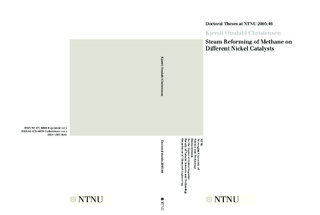| dc.contributor.author | Christensen, Kjersti Omdahl | nb_NO |
| dc.date.accessioned | 2014-12-19T13:22:54Z | |
| dc.date.available | 2014-12-19T13:22:54Z | |
| dc.date.created | 2008-05-08 | nb_NO |
| dc.date.issued | 2005 | nb_NO |
| dc.identifier | 124319 | nb_NO |
| dc.identifier.isbn | 82-471-6959-2 | nb_NO |
| dc.identifier.uri | http://hdl.handle.net/11250/248086 | |
| dc.description.abstract | The effect of crystal size on carbon formation and sintering was studied on nickel catalysts at steam reforming conditions. Different nickel supported catalysts were examined. As support three commercial hydrotalcites were used: HT30 (MgO/Al2O3 = 3/7), HT50 (MgO/Al2O3 = 5/5) and HT70 (MgO/Al2O3 = 7/3). These supports were compared with CaO-Al2O3 and α-Al2O3. For the sintering experiments an industrial Ni/CaAl2O4 catalyst was used for comparison. The hydrotalcite derived catalysts had different Mg/Al ratios and the lowest Mg/Al ratio gave the highest Ni dispersion. The hydrotalcite derived catalysts also had a higher dispersion than NiO/CaO-Al2O3, NiO/α-Al2O3 and Ni/CaAl2O4.
Carbon formation studies were performed in the tapered element oscillating microbalance (TEOM) at 823K, total pressure of 20 bar and steam to carbon (S/C) ratios of 0.08 to 2.4. The TEOM is a powerful tool for in situ catalyst characterization. All the feed gases pass through the catalysts bed and the TEOM offers a high mass resolution and a short response time. With an on-line gas chromatograph or mass spectrometer, catalyst activity and selectivity can be determined as a function of time. From the TEOM experiments it seemed that the Ni crystal size had a large effect on the carbon threshold value (S/C ratio where the carbon gasification rate equals the carbon deposition rate). Increased crystal size gave an increased carbon threshold value. It was concluded that small nickel crystals resulted in a large saturation concentration of carbon giving a low driving force for carbon diffusion and hence a lower coking rate. TOF increased with increasing Ni crystal size. This could be explained by surface inhomogeneities on the large crystals. Sintering experiments were performed at 903K and 20 bar in a fixed-bed reactor system. For all the catalysts the sintering mechanism involving particle migration seemed to be dominating. Due to a higher degree of wetting of the substrate by the nickel particle, the catalysts with smallest nickel particles showed the highest resistance towards sintering.
Hydrogenolysis of methane was used as a probe reaction for testing the catalysts activity. An increased TOF with increased Ni particle size was observed. This result coincides with results from the steam methane reforming experiments in the TEOM.
The characteristics of the hydrotalcite derived catalysts prepared by impregnation of commercial hydrotalcite supports were compared with hydrotalcite derived catalysts prepared by the co-precipitation method. An improved dispersion with decreasing Mg/Al ratio in the hydrotalcite was found. The catalysts prepared by the co-precipitation method maintained a high dispersion at increased nickel loadings. Different techniques were used to determine the Ni particle size. The results showed an excellent correlation between the Ni particle size found by chemisorption, X-ray diffraction (XRD), transmission electron microscopy (TEM) and scanning transmission electron microscopy (STEM). | nb_NO |
| dc.language | eng | nb_NO |
| dc.publisher | Fakultet for naturvitenskap og teknologi | nb_NO |
| dc.relation.ispartofseries | Doktoravhandlinger ved NTNU, 1503-8181; 2005:46 | nb_NO |
| dc.relation.haspart | Christensen, K. O; Chen, D; Lødeng, R; Holmen, A. Effect of Crystal Size on Carbon Formation and Sintering of Hydrotalcite Derived Ni-catalysts. Applied Catalysis A: General. 314(1): 9-22, 2006. | nb_NO |
| dc.relation.haspart | Bjørgum, E; Christensen, K. O; Lødeng, R; Chen, D; Holmen, A. In situ Catalyst Characterization by the Oscillating Microbalance Catalytic Reactor (TEOM). Advances in Catalysis. 51: 351-382, 2007. | nb_NO |
| dc.relation.haspart | Chen, D; Lødeng, R; Christensen, K. O; Anundskås, A; Olsvik, O; Holmen, A. A model for reforming on Ni catalysts with carbon formation and deactivation. Studies in Surface Science and Catalysis. 139: 93, 2001. | nb_NO |
| dc.relation.haspart | Chen, D; Christensen, K. O; Ochoa-Fernández, E; Yu, Z; Tøtdal, B; Latorre, N; Monzon, A; Holmen, A. Syntehsis of carbon nanofibers. Journal of Catalysis. 229(1): 82-96, 2005. | nb_NO |
| dc.relation.haspart | Chen, D; Bjørgum, E; Lødeng, R; Christensen, K. O; Holmen, A. Microkinetic model assisted design for steam methane reforming. Studies in Surface Science and Catalysis. 147: 139, 2004. | nb_NO |
| dc.relation.haspart | Bjørgum, E; Chen, D; Bakken, M. G; Christensen, K. O; Holmen, A. Energetic Mapping of Ni Catalysts by Detailed Kinetic Modeling. J. Phys. Chem B. 109: 2360-2370, 2005. | nb_NO |
| dc.title | Steam Reforming of Methane on Different Nickel Catalysts | nb_NO |
| dc.type | Doctoral thesis | nb_NO |
| dc.contributor.department | Norges teknisk-naturvitenskapelige universitet, Fakultet for naturvitenskap og teknologi, Institutt for kjemisk prosessteknologi | nb_NO |
| dc.description.degree | dr.ing. | nb_NO |
| dc.description.degree | dr.ing. | en_GB |
